Climate on the Earth is controlled by the interactions among atmosphere, ocean, and land surface. In the Laboratory of Physical Oceanography and Climate, we focus on the atmosphere and ocean with temporal variations from daily weather to climate changes and with spatial ranges from regional to global scales. We aim to discover and explain a variety of phenomena concerning the atmosphere and ocean.
We are now introducing several key themes of our laboratory:
- The atmosphere and ocean interaction in the mid-latitudes,
- Decadal variability in the atmosphere and ocean,
- Atmosphere and ocean dynamics,
- Regional climate variability, and
- Interdisciplinary studies.
The atmosphere and ocean interaction in the mid-latitudes
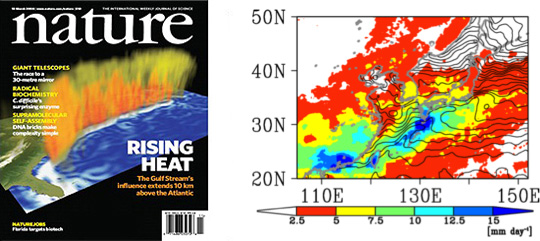
Figure 1: (left) A discovery of the effects of the Atlantic Gulf Stream to the troposphere graced the cover of the issue 13 March 2008 in Nature.(right) Monthly mean precipitation rate (color; mm day-1) and sea surface temperature (contour; °C) in June. The precipitation is enhanced over the warm sea surface temperature of the Kuroshio Current in the East China Sea.
The impact of the ocean on the atmosphere plays an important role in determining the nature of the Earth's climate. The mid-latitude oceanic effect on the atmosphere has been studied for a long time, but we still have many unsolved problems. New approaches to the problems using modern satellite observation for surface wind and rainfall and high-resolution and long-term numerical simulations with high-spec computers are just making a breakthrough in the international society of this field. Our laboratory has contributed to such a recent scientific development in the study of mid-latitude air-sea interaction.
Minobe et al. (2008) discovered the effect of the Gulf Stream in the Atlantic to the troposphere by analyzing satellite observation data and atmosphere-ocean simulations. This study was praised by the international community and graced the cover of Nature, the issue of 13 March 2008 (left in Figure 1). The paper was selected as a highly-referred paper by Thomson Reuter. The paper was also selected as the research front paper in the field of the atmosphere-ocean interaction. Regarding the paper as a milestone, our laboratory is extensively working on the mid-latitude atmosphere-ocean interaction problems. For example, Minobe et al. (2010) found that the atmospheric response to the oceanic flow can be classified into shallow and deep heating modes.
To investigate the mid-atmosphere-ocean interaction around sea surface temperature fronts, it is necessary to use high-resolution numerical simulations and in-situ observations. Sasaki et al. (2012) combined the results of satellite observations and nonhydrostatic regional atmospheric model and showed that the precipitation associated with Early Summer (Baiu) rainband is enhanced over the warm sea surface temperature of the Kuroshio current in the East China Sea (right in Figure 1). We conducted in-situ ship observations in the East China Sea in June, and Mori (2014, master thesis) reported that atmospheric conditions over the warm sea surface temperature of the Kuroshio Current favour convective instability.
We now vigorously advance a project to deeply consider the air-sea interaction in the mid-latitudes from points of view of meteorology and oceanography.
Decadal variability in the atmosphere and ocean
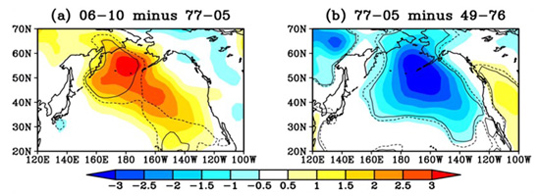
Figure 2:(left) The recent air pressure change in the North Pacific (difference between 2006-2010 average and 1977-2005 average) and (right) the air pressure change in the climate regime shift period (difference between 1977-2005 average and 1949-1976 average). While air pressure was decreasing in the North Pacific in 1970s, that is now increasing.
Studies on climate change include seasonal, inter-annual, decadal, and inter-decadal variability. Many papers on climate change have been published since 1980s; yet many problems on decadal variability remain unsolved. Decadal variability is more mysterious than inter-annual variability such as El Nino and Southern Oscillation.
We, Laboratory of Physical Oceanography and Climate, discovered a penta-decadal variation in the North Pacific (Minobe, 1997) and revealed that it was synchronized with a 20-year variation (Minobe, 1999). These papers have been cited in numerous papers as well as in the fourth and fifth Assessment Report of Intergovernmental Panel on Climate Change (IPCC, 2007; 2013).
Related to decadal variability, an interesting signature can be found in recent observations (Figure 2). As we already knew that the Pacific decadal variability abruptly changed its signature and we called it climate regime shift, we guessed that a recent change of signature could be interpreted as a regime shift. Since the atmosphere and ocean are monitored with a denser observation network currently rather than 1970s, when the last regime shift in the 20th century was observed, we hope that we can answer whether or not the recent signal represents a regime shift.
Atmosphere and ocean dynamics
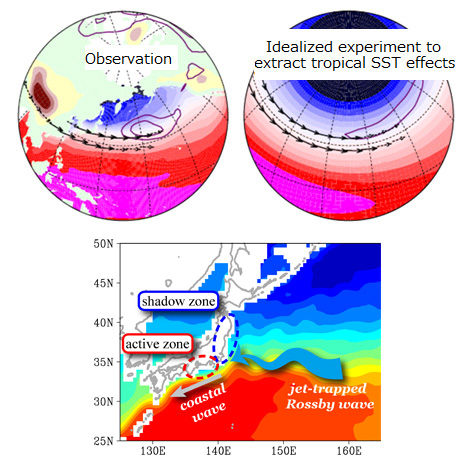
Figure 3: (upper left) Wintertime jet stream over Japan, and surface height on land and sea surface temperatures in the ocean. (upper right) Result of atmospheric simulations with an aqua planet and with idealized tropical sea surface temperature distribution. (lower) Schematic diagram illustrating the mechanism of the sea level changes along the coast of Japan. The incoming jet-trapped Rossby wave induces Kuroshio Extension variability, and it causes coastal sea-level changes along the coast of Japan. An "active zone" and a "shadow zone" denote the region where the resultant coastal sea-level change is large and small, respectively.
To understand the motion of the atmosphere and oceans is important to think of climate changes that involves complex processes.
Upper tropospheric wind over Japan, called the jet stream, is fastest air motion around the world. Atmospheric simulations are helpful to consider what causes the jet stream. We can add and remove a variety of agents in the simulation. Inatsu et al. (2000, 2002) suggested that one of the causes of the jet stream over Japan is tropical warm water around Indonesia (upper in Figure 3).
Strong flows also exist in the ocean. The Kuroshio, an ocean current along Japan, separates from the Japan coast and flows eastward. This eastward current is called the Kuroshio Extension, which is one of the fastest currents in the world. This current transports warm water polewards and yields large heat release from the ocean to the atmosphere. The mechanism for Kuroshio Extension variability is one of important problems in physical oceanography. Our study revealed that a so-called jet-trapped Rossby wave, induced by wind fluctuations causes Kuroshio Extension variability (Sasaki et al. 2013). Furthermore, we also found that the Kuroshio Extension variability results in coastal sea-level changes along Japan (lower in Figure 3; Sasaki et al. 2014). These results indicate that a better understanding of western boundary currents is necessary for reliable prediction of future coastal sea level changes.
Simulations using simple models are useful to extract the dynamical essence of physical phenomena. A graduate student is able to develop a simple model from scratch or to extend a simple model that a senior student has already coded. Actually Ichikawa (2012, master thesis) is constructing a novel ocean simple model to understand the tropical ocean with a new theoretical framework. We hope that we can construct a new framework with the novel model in our group that could be disclosed to researchers all over the world.
Regional climate variability
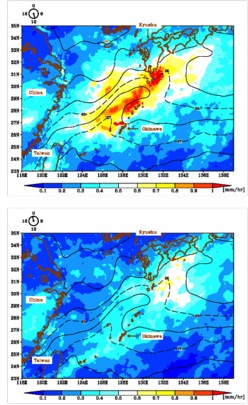
Figure 4: (left) Extratropical cyclone activity difference between global-warming and present-climate simulations by the Kyosei project; red and blue denote more and less active, respectively. (right) Monthly mean precipitation rate (color) at 1100 JST (0200 UTC) and 2300 JST (1400 UTC) on June. Contours denote sea surface temperature, and a southeast-northeast oriented warm temperature tongue around 24°N?27°N indicates the warm Kuroshio Current, which flows along the Ryukyu Islands in the East China Sea. Over the Kuroshio, prominent diurnal precipitation variability occurs and its peak is 1100 JST (0200 UTC). This diurnal variability can be seen in this animation (press this link).
Studies on snow by Dr. Ukichiro Nakaya are very famous in the history of earth physics in Hokkaido University. As Hokkaido has a cold climate, there are several aspects of regional climate that make it different from the mainland, with a temperate or a subtropical zone. We think that the cold regional climate has the potential to also be important to climate studies from a global point of view.
Climate variations in Hokkaido in winter are characterized by a state with a severely cold temperature, with more snowfall on the Japan-Sea side and a state with a moderately cold temperature, with more snowfall on the Pacific side. The former is related to the strength of the climatological pressure pattern with the Aleutian low and the Siberian high, and the latter is related to the extra-tropical cyclones passing along the south coast of Japan. As we have already known that the former and the latter are contrarily observed, the recent global warming project revealed that the global warming forcing would shift Hokkaido's climate to the latter state (Inatsu and Kimoto 2005). We are involved in an ongoing project on Hokkaido climate change by using down-scalings (left in Figure 4). Many students and former students have contributed to this project (Kuno and Inatsu 2014).
Zooming out from Hokkaido, the relationship between Japanese climate and ocean is also an interesting topic of research. Takebayashi (2013, master thesis) found diurnal precipitation variability over the Kuroshio in the East China Sea in early summer (Meiyu-Baiu) season (right in Figure 4). We also found similar diurnal precipitation variability over the Gulf Stream in the North Atlantic. Hence, the diurnal precipitation fluctuations have universal values. These results have been summarized and submitted (Minobe and Takebayashi, 2014).
Interdisciplinary studies
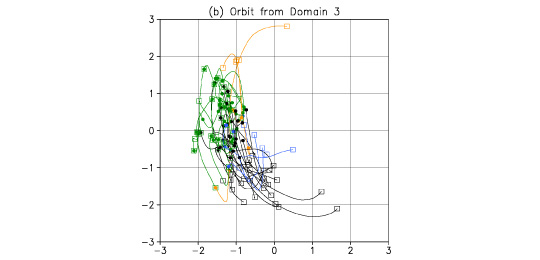
Figure 5: Trajectories in the phase space spanned by two leading mode of the stratospheric circulation.
Physical Oceanography and Climate Laboratory covers not only pure science on atmosphere and ocean physics but also interdisciplinary studies related to the Earth's environment or oceanic bio-geochemistry.
As an example of the collaboration with mathematics, we cope with a theoretical study on the prediction error by using stochastic analysis. The atmospheric variability almost follows the partial differential equation of fluids with a very large amount of degrees of freedom, but it might be possible to reduce the number to pick up low frequency variability. If we found some character in the orbits in the phase space, this notion could help the subseasonal prediction. We are also actively developing the method of error prediction with stochastic differential equations (Figure 5; Inatsu et al., 2013).
In addition, we are first finding large-scale variations of oceanic nutrients and oxygen. Global warming will increase air temperature rather than oceanic temperature and then the increase of surface oceanic layer will be greater than that of bottom oceanic layer. This will prevent the ocean from mixing vertically. As the photosynthesis is active near the surface, less mixing decreases the transport of nutrients downwards. Without any transport of nutrients from the surface, the ocean would not keep any marine ecosystem. If the nutrients decreased, oceanic photosynthesis, oceanic organic materials, and ecosystem would then decrease and, as a consequence, many species would be driven to the verge of extinction and marine products would decrease; Besides that, the absorption of carbon dioxide could be reduced and global warming could be accelerated, because the organic products play a role of the absorption of atmospheric carbon dioxide. However, in spite of these grave concerns, the lack of observations is a stumbling block to check whether the change of oceanic nutrients is consistent with this hypothetical story or not. We now prepare a dataset that enables us to analyze the oceanic oxygen, closely related to the nutrients. These studies will be developed in the near future. We are starting an international collaboration on this topic.
References
- Inatsu, M., H. Mukougawa, and S.-P. Xie, 2000: Formation of subtropical westerly jet core in an idealized GCM without mountains. Geophys. Res. Lett., 27, 529-532.
- Inatsu, M., and M. Kimoto, 2005a: Two types of interannual variability of the mid-winter storm-tracks and their relationship to global warming. SOLA, 1, 61-64.
- Inatsu, M., and M. Kimoto, 2005b: Difference of boreal summer climate between coupled and atmosphere-only GCMs. SOLA, 1, 105-108.
- Kuno, R., and M. Inatsu, 2013: Development of sampling downscaling: A case for wintertime precipitation in Hokkaido. Clim. Dyn., in revision.
- Minobe, S., 1997: A 50-70 year climatic oscillation over the North Pacific and North America. Geophysical Research Letters, 24, 683-686.
- Minobe, S., 1999: Resonance in bidecadal and pentadecadal climate oscillations over the North Pacific: Role in climatic regime shifts. Geophysical Research Letters, 26, 855-858.
- Minobe, S., A.Kuwano-Yoshida, N. Komori, S.-P.Xie, and R. J. Small, 2008: Influence of the Gulf Stream on the troposphere, Nature, 452, 206-209.
- Minobe, S., M. Miyashita, A. Kuwano-Yoshida, H. Tokinaga, and S.-P. Xie, 2010: Atmospheric response to the Gulf Stream: Seasonal variations, Journal of Climate, 23, 3699-3719.
- Minobe S., and S. Takebayashi, 2014: Diurnal precipitation and high cloud frequency variability over the Gulf Stream and over the Kuroshio. Climate Dynamics, submitted.
- Sasaki, Y. N., S. Minobe, T. Asai, and M. Inatsu, 2012: Influence of the Kuroshio in the East China Sea on the early summer (Baiu) rain. Journal of Climate, 27, 6627-6645.
- Sasaki, Y. N., S. Minobe and N. Schneider, 2013: Decadal response of the Kuroshio Extension jet to Rossby waves: Observation and thin-jet theory. Journal of Physical Oceanography, 43, 442-456.
- Sasaki, Y. N., S. Minobe and Y. Miura, 2014: Decadal sea level variability along the coast of Japan in response to ocean circulation changes. Journal of Geophysical Research-Oceans, 119, doi:10.1002/2013JC009327.
